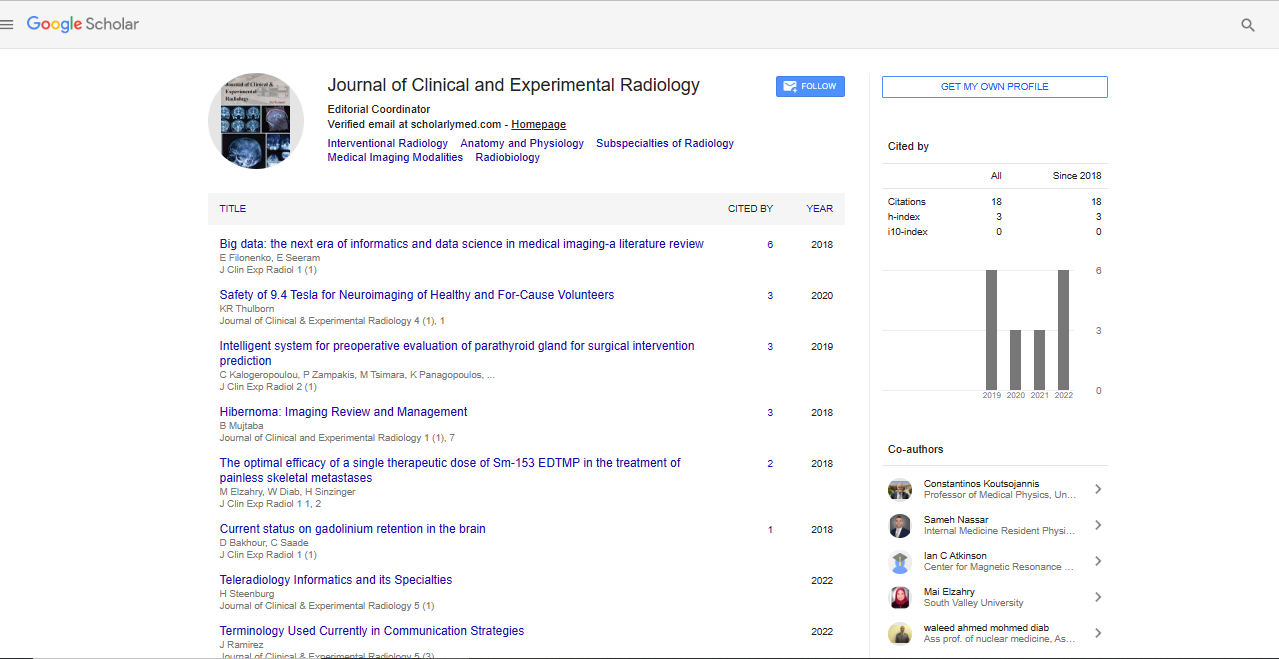Opinion Article, Vol: 6 Issue: 2
Radiation Physics in Space Effects of Cosmic Radiation on Astronauts and Equipment
Michael Williams*
1Department of Nuclear and Radiation Safety Research Center, Egyptian Atomic Energy Authority, Egypt
*Corresponding Author: Michael Williams,
Department, Nuclear and Radiation
Safety Research Center, Egyptian Atomic Energy Authority, Egypt
E-mail: williams_mich@yahoo.com
Received date: 30 August, 2023, Manuscript No. JCER-23-116670;
Editor assigned date: 01 September, 2023, PreQC No. JCER-23-116670 (PQ);
Reviewed date: 15 September, 2023, QC No. JCER-23-116670;
Revised date: 22 September, 2023, Manuscript No. JCER-23-116670 (R);
Published date: 29 September, 2023, DOI: 10.4172/jcer.1000145
Citation: Williams M (2023) Radiation Physics in Space Effects of Cosmic Radiation on Astronauts and Equipment. J Clin Exp Radiol 6:3.
Description
Space exploration has long captivated the human imagination, but it comes with unique challenges, including the presence of cosmic radiation. Cosmic radiation, consisting of high-energy particles from space, poses significant threats to both astronauts and their equipment. Understanding the physics of radiation in space and its effects on astronauts and equipment is crucial for ensuring the safety and success of space missions. This essay delves into the fundamentals of radiation physics in space, exploring the effects of cosmic radiation on astronauts and equipment.
Cosmic radiation is a complex mix of high-energy particles, including protons, electrons, and heavy ions, originating from various sources in the universe. The most significant sources of cosmic radiation include the Sun, which emits solar particles during solar flares and coronal mass ejections, and Galactic Cosmic Rays (GCRs) that originate from outside our solar system. Earth's magnetic field and atmosphere offer significant protection from cosmic radiation to those on the surface. However, space travelers, including astronauts, are exposed to elevated levels of cosmic radiation.
Radiation in space is different from terrestrial radiation in several ways. One crucial distinction is the absence of a protective atmosphere in space, which allows cosmic radiation to penetrate spacecraft and affect astronauts. Additionally, the high-energy nature of cosmic radiation particles poses unique challenges. When these particles collide with matter, they produce secondary radiation, including neutrons, electrons, and gamma rays. This secondary radiation can also be harmful, making it essential to understand the physics behind these interactions.
One key concept in radiation physics is the measurement of radiation dose, typically expressed in Sie Verts (Sv). Astronauts in space are exposed to a complex mix of radiation types, and this exposure can vary significantly depending on factors such as solar activity and the duration of the mission. Understanding the total radiation dose and its distribution is critical for assessing the risks and ensuring astronaut safety.
The effects of cosmic radiation on astronauts can be broadly categorized into acute and chronic effects. Acute effects occur as a result of high doses of radiation received in a short period, such as during a solar particle event. These effects can include radiation sickness, which manifests as nausea, vomiting, and fatigue. Acute radiation exposure can also increase the risk of cancer and damage critical biological tissues, including the central nervous system and the gastrointestinal tract. Chronic effects, on the other hand, result from long-term exposure to lower doses of radiation. These effects are particularly concerning for astronauts on extended missions, such as those traveling to Mars. Chronic radiation exposure can lead to a higher risk of developing cancer, cataracts, and other long-term health issues. Therefore, mitigating chronic exposure is a significant concern in space travel. Protecting astronauts from cosmic radiation is a complex task. Shielding spacecraft with thick layers of materials can help reduce radiation exposure, but it adds weight to the spacecraft and poses engineering challenges. Additionally, astronauts can take measures to limit exposure during solar particle events by staying in more shielded areas of the spacecraft, but these events can be difficult to predict accurately.
Cosmic radiation not only affects astronauts but also poses risks to spacecraft and equipment. The high-energy particles in space can damage electronic components and affect the reliability of onboard systems. For instance, Single Event Upsets (SEUs) occur when a highenergy particle strikes a sensitive component, causing a temporary change in the state of a memory cell or processor. SEUs can lead to data corruption and system malfunctions, potentially compromising the success of a mission. Space agencies and organizations must design and test spacecraft to withstand the effects of cosmic radiation. This often involves using radiation-hardened components, shielding sensitive equipment, and developing redundancy in critical systems. These measures help minimize the risk of radiation-induced failures during space missions. Radiation physics in space is a critical field of study with profound implications for space exploration. Cosmic radiation presents unique challenges, both for astronauts and their equipment. The effects of cosmic radiation on astronauts, including acute and chronic health risks, underscore the need for robust safety measures and effective shielding. Additionally, the potential damage to spacecraft and equipment highlights the importance of engineering solutions and redundancy in critical systems. As humanity embarks on longer-duration space missions, such as journeys to Mars and beyond, understanding and mitigating the effects of cosmic radiation becomes even more imperative. Research in radiation physics, coupled with advances in spacecraft design and safety protocols, will continue to play a pivotal role in ensuring the success and well-being of astronauts exploring the cosmos.
 Spanish
Spanish  Chinese
Chinese  Russian
Russian  German
German  French
French  Japanese
Japanese  Portuguese
Portuguese  Hindi
Hindi 